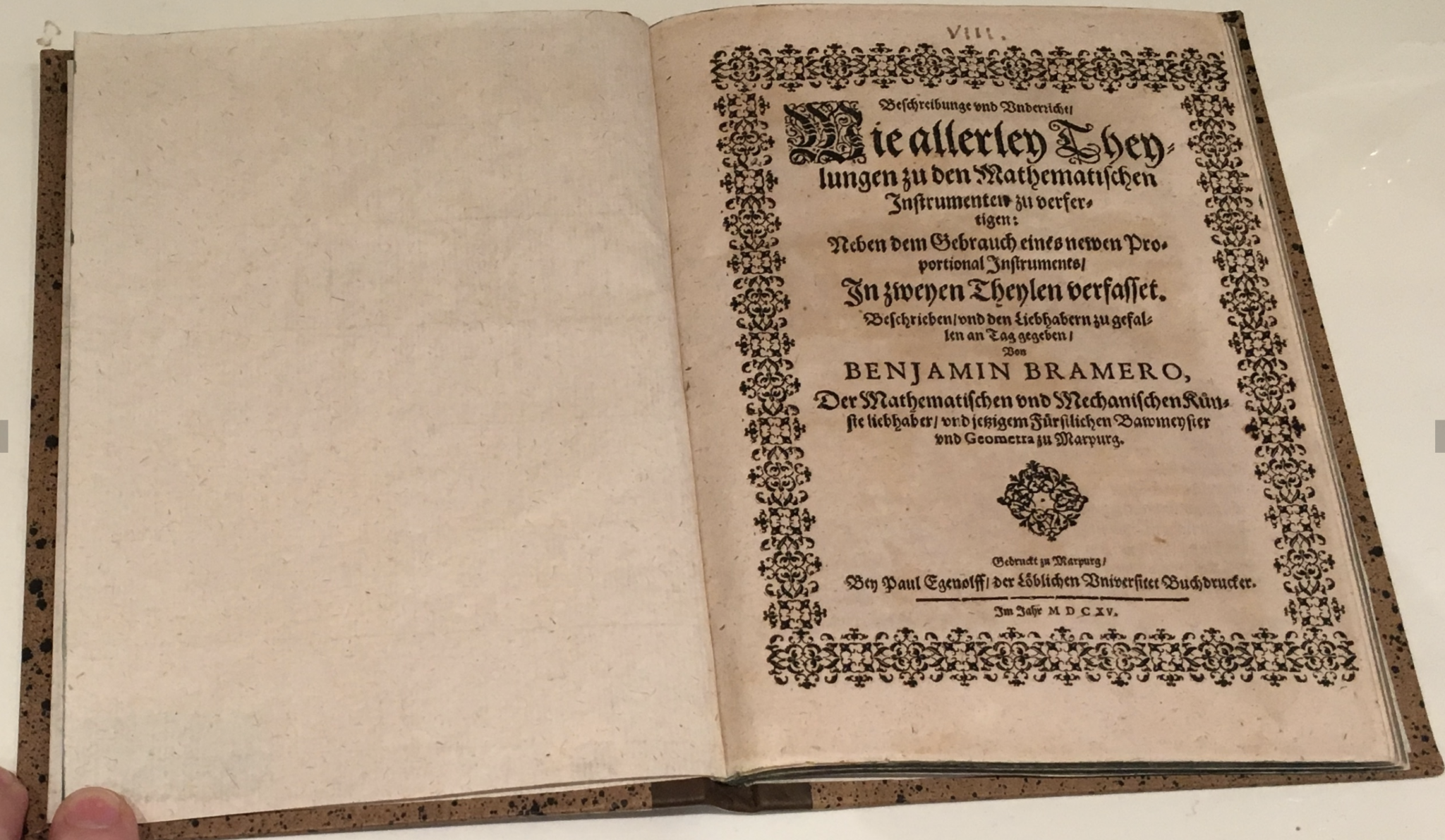Description
BRAMER, Benjamin. Beschreibunge und Underricht wie allerley Theylungen zu den Mathematischen Instrumenten zu verfertigen: neben dem Gebrauch eines newen Proportional Instruments in zweyen Theylen verfasset. Marburg: Paul Egenolff, 1615.
First edition, extremely rare, of Bramer’s work describing a new kind of sector, or proportional compass, having more sophisticated scales than Galileo’s model – the sector was the earliest multi-purpose mechanical calculating device. This work is one of only a handful of very rare tracts on the sector published in the decade following the appearance of Galileo’s ‘Le operazioni del compasso geometrico’ (1606). Bramer was a propagandist and reformer of the sector invented by Galileo, and he refers to Galileo twice in his book (pp. 5 & 91). Bramer’s work influenced Descartes who, in the spring of 1619, intended to accomplish the unification of arithmetic and geometry with the aid of mathematical compasses, not necessarily in the purely written form of algebra. Descartes refers to Bramer in his ‘Cogitates privatae’ (see Sasaki, Descartes’s Mathematical Thought).
“Bramer’s sector is interesting for its use of a removable arm, hinged with a pin through a hole at the end of each scale, which avoids the problem of making a complex hinge. This innovation also allowed him to construct each scale on an individual line, thus avoiding the problem of interfering scale graduations near the hinge (where all scales come together at a point in the usual form of the instrument). The sector was equipped with scales for arithmetic (usually termed a line of lines), a line of circles, a geometric line (for working with triangles), a line of planes (for manipulating areas) and a line of solids (for volumes) as well as others for gnomic calculations . . . in his introduction addressed to the reader [Bramer] mentions prior work by Joost Burgi, Galileo and Phillipp Horcher . . . The first chapters deal with basic geometrical concepts, and the second part deals in depth with the construction of Bramer’s instrument and the division of its scales. Bramer’s sector is unusual in that it only uses one movable arm. To facilitate dividing the scales, Bramer provides numerous tables (primes, quadratic, cubic, etc.) and explains their use in some detail. For example, in Chapter 1, the author deals with straight lines and provides a table from 1 to 999 indicating which are prime numbers and giving the divisors of those that are not prime. The remainder of Chapter 1 is devoted to applications of this table. In Chapter 2 the subject is the division of an arc of a circle and a rudimentary form of the Bramer sector is introduced. Succeeding chapters deal with subjects of ever-increasing complexity” (Tomash & Williams).
Bramer (1588-1632) was raised in the household of his sister, whose husband was the mathematician and instrument maker Joost Burgi, famous for his invention of logarithms (at about the same time as, and independently of, Napier). The improved accuracy of Burgi’s astronomical and surveying instruments led to his appointment in Prague, where he worked closely with Kepler, and was responsible for the great astronomer’s calculations. Growing up in such a milieu, Bramer received an outstanding training in mathematics, and his gifts were apparent at an early age.
OCLC lists Smithsonian only in US (Bern Dibner’s copy). ABPC/RBH list only this and the Honeyman copy (Sotheby’s, 30 October 1978, lot 494, £170; Chayette & Cheval, 27 May 2009, lot 333, EUR 3100), which was also in a modern binding. Tomash & Williams ADD 9 (this copy).
Small 4to, pp. [1-2], 3-92 with 2 folded plates, including 3 full-page illustrations and numerous woodcuts in the text (browning, occasionally heavy, due to the quality of the paper, a small tear to each plate). Modern quarter-calf and speckled boards, two red lettering-pieces on spine (bookplate of Erwin Tomash on front paste-down).











